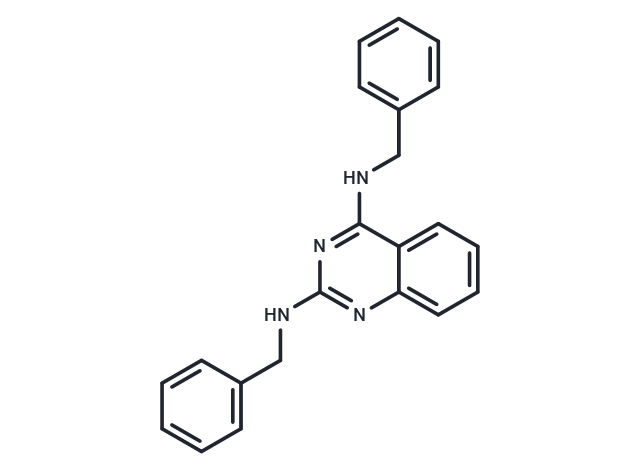Shopping Cart
- Remove All
 Your shopping cart is currently empty
Your shopping cart is currently empty

DBEQ (JRF 12) is a selective, potent, reversible, and ATP-competitive p97 inhibitor.

| Pack Size | Price | Availability | Quantity |
|---|---|---|---|
| 5 mg | $53 | In Stock | |
| 10 mg | $96 | In Stock | |
| 25 mg | $190 | In Stock | |
| 50 mg | $342 | In Stock | |
| 100 mg | $432 | In Stock | |
| 200 mg | $639 | In Stock | |
| 500 mg | $987 | In Stock | |
| 1 mL x 10 mM (in DMSO) | $54 | In Stock |
| Description | DBEQ (JRF 12) is a selective, potent, reversible, and ATP-competitive p97 inhibitor. |
| Targets&IC50 | p97:1.5 μM |
| In vitro | 10 μM DBEQ completely inhibited the degradation of virus and antibody, but not IgG Fc. 10 μM DBeQ rapidly promoted caspases-3 and -7 activation in HeLa cells. DBeQ activated the intrinsic caspase-9 apoptotic pathway more efficiently than the extrinsic caspase-8 pathway, while STS activated both pathways to a similar extent. 10 μM DBeQ effectively inhibited the degradation of TCRα-GFP in HEK293 cells. 10 μM DBeQ dose-dependently induced CHOP in HEK293 cells within 3 hours, but it did not increase the level of p21. DBeQ in U20S cells decreased basic and nutrient-stimulated MTOR target phosphorylation, similar to the effect of rapamycin.15 μM DBeQ in Hela cells induced a large accumulation of LC3-II in the nucleus as well as in condensed membrane and cytoplasmic fractions.DBeQ in HeLa cells inhibited the degradation of UbG76V-GFP, ODD-Luc and Luc-ODC degradation, and inhibited the degradation of UbG76V-GFP. Luc-ODC degradation with IC50s of 2.6 μM, 56 μM and 45 μM, respectively. |
| In vivo | At a concentration of 10 μM, DBeQ effectively inhibits the degradation of viruses and antibodies, without affecting the degradation of IgG Fc. It rapidly facilitates the activation of caspases-3 and -7 in HeLa cells, demonstrating a more potent activation of the intrinsic caspase-9 apoptosis pathway compared to the extrinsic caspase-8 pathway, while Staurosporine (STS) similarly activates both pathways. Additionally, 10 μM DBeQ blocks the degradation of TCRα-GFP in HEK293 cells. In HEK293 cells, DBeQ dose-dependently induces CHOP within 3 hours without increasing p21 levels. It diminishes the phosphorylation of basal and nutrient-stimulated mTOR targets in U2OS cells, similar to the effects of Rapamycin. At 15 μM, DBeQ induces a significant accumulation of LC3-II in the nuclei, membrane concentrations, and cytoplasm of HeLa cells. Furthermore, DBeQ inhibits the degradation of UbG76V-GFP, ODD-Luc, and Luc-ODC in HeLa cells, with IC50 values of 2.6 μM, 56 μM, and 45 μM, respectively. |
| Kinase Assay | Manual ATPase Assay: Assay Buffer [20 μL of 2.5× concentration, where 1× = 50 mM Tris (pH 7.4), 20 mM MgCl2, 1 mM EDTA, and 0.5 mM tris(2-carboxyethyl)phosphine (TCEP)] is dispensed into each well of a 96-well plate. Puri?ed p97 (25 μL of 50 μM) is diluted in 975 μL of 1× Assay Buffer, and 10 μL is dispensed in each well. DBeQ (10 μL) or 5% DMSO (10 μL) is then added to each well, and the plate is incubated at room temperature for 10 min. The ATPase assay is carried out by adding to each well 10 μL of 500 μM ATP (pH 7.5), incubating at room temperature for 60 min, and then adding 50 μL Kinase Glo Plus reagent, followed by a ?nal 10-min incubation at room temperature in the dark. Luminescence is read on an Analyst AD. DBeQ is assayed at a range of concentrations (0, 0.048, 0.24, 1.2, 6, and 30 μM) in triplicate. |
| Cell Research | Cells are seeded on a 384-well solid white plate (5,000 cells/well). Cells are transfected with luciferase siRNA or p97 siRNA (10 nM) for 48 hours or treated with DBeQ for the indicated amount of time. Caspase-3/7 Glo, caspase-6 Glo, caspase-8 Glo, or caspase-9 Glo is added into each well and mixed by shaking at 500 rpm for 1 min. Luminescence signal is determined after incubation at room temperature for 1 hour. Cellular viability is determined with CellTiter-Glo reagen. To determine the IC50 of cellular viability, cells are treated with MG132 or DBeQ at seven concentrations (threefold serial dilutions starting at 33 μM) for 48 hours. IC50 values are calculated from ?tting the percentage of luminescence signal normalized to DMSO treated cells).(Only for Reference) |
| Alias | JRF 12 |
| Molecular Weight | 340.42 |
| Formula | C22H20N4 |
| Cas No. | 177355-84-9 |
| Smiles | C(Nc1nc(NCc2ccccc2)c2ccccc2n1)c1ccccc1 |
| Relative Density. | 1.259 g/cm3 (Predicted) |
| Storage | Powder: -20°C for 3 years | In solvent: -80°C for 1 year | Shipping with blue ice. | ||||||||||||||||||||
| Solubility Information | DMSO: 3.85 mg/mL (11.3 mM), Sonication is recommended. | ||||||||||||||||||||
Solution Preparation Table | |||||||||||||||||||||
DMSO
| |||||||||||||||||||||

Copyright © 2015-2025 TargetMol Chemicals Inc. All Rights Reserved.